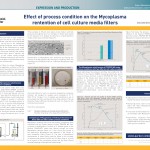
A Mycoplasma contamination event can have a major impact on a biopharmaceutical manufacturer. The loss of a cell culture due to a contamination incurs significant costs that can be attributed to both the initial bioreactor set-up and to the subsequent decontamination. Production facility throughput may be affected and in the worst cases the ability of the manufacturer to supply patients with medicines. Mycoplasma are extremely small in size and lack a cell wall giving the cells some flexibility that enables them to penetrate the 0.2 micron filters used to ‘sterilize’ cell culture media. The filtration of cell culture media through 0.1 micron filters alongside the effective screening of cell lines for infection and adherence to GMP principles of contamination control will minimize the risk of bioreactor contamination.
Typically the retention ability of filters to remove Mycoplasma is measured using the standard application outlined in PDA 26, replacing the standard test organism Brevundimonas diminuta with the Mycoplasma species Acholeplasma laidlawii. This poster, however, demonstrates the importance of understanding how filters perform under typical process conditions in order to provide information that is valuable to the end user.
